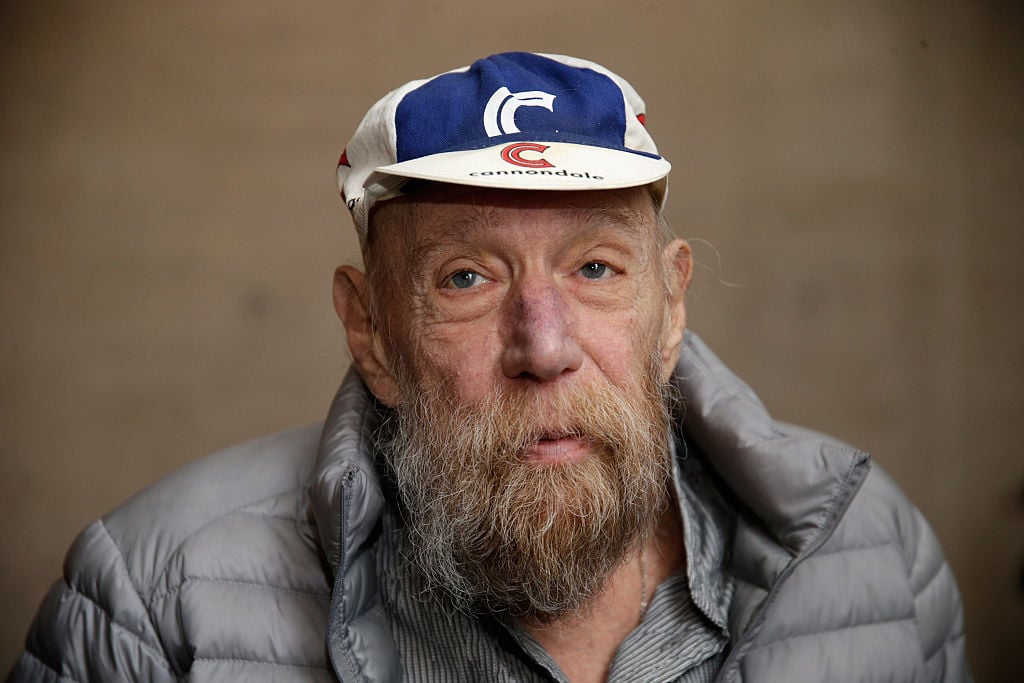
Lawrence Weiner, a pioneering conceptualist who used language to question the conventions of art, died on December 1. He was 79.
The news was confirmed by his dealers Lisson Gallery, i8 Gallery, and Marian Goodman Gallery. A cause of death was not provided.
“I am heartbroken,” dealer Marian Goodman said in a statement. “He proposed a new relationship to art and redefined the position of the artist, and his works demonstrated the power of language worldwide.”
Lawrence Weiner, THE BOULDERS ON TOP RENT & SPLIT (1987). Courtesy of the artist and Marian Goodman Gallery, New York. Photo by Cathy Carver.
Best known for his text-based installations, for which he would paint phrases both profound and prosaic on walls, t-shirts, and any number of other objects, Weiner believed that language alone could constitute a work of art. He referred to himself as a sculptor, despite the fact that his creations were often confined to two dimensions. “Better described as thought sculptures, Weiner defined his sculptural medium simply as ‘language + the material referred to,’ in the sense that language is a material for construction,” a statement from Lisson explained.
Weiner was born in 1942 in the Bronx, New York, where his parents owned a candy store. After high school came a series of odd jobs (he worked on an oil tanker and unloaded railroad cars) and a brief stretch at Hunter College before he dropped out to travel the country.
He created his first major work of art at age 18, when he used explosives to blow up the four corners of a field in Northern California. Cratering Piece was the name of the artwork, which comprised both the action of the explosion and the marks in the earth it created. It marked the beginning of a career defined by questioning what art is and could be.
Lawrence Weiner, SPREAD AS THIN AS CAN BE (2016). Photo: Photo: Courtesy of Regen Projects, Los Angeles
For a 1968 exhibition organized by dealer Seth Siegelaub at a college in Vermont, Weiner created Statements, a small book of assertions about the nature of art. Among them was “Declaration of Intent,” a kind of mission statement for the artist now considered a seminal text in the conceptualism movement. It read: “(1) The artist may construct the piece. (2) The piece may be fabricated. (3) The piece may not be built. [Each being equal and consistent with the intent of the artist, the decision as to condition rests with the receiver upon the occasion of receivership.]”
By the mid-70s, Weiner was working with the words-on-walls installations that would come to define his career, establishing a basic template: the text was plain (a sans-serif, often stenciled) and could be painted by someone else so long as that person adhered to the artist’s instructions. His approach helped define a novel approach coming to the fore at the time shared by artists such as Sol LeWitt and Joseph Kosuth: that it is the idea, not the expression of the idea, that constitutes the work of art.
What distinguished Weiner from some of his other conceptual brethren was his wit, humor, and commitment to language as a mode of expression. “He folds together the skills of a Russian Constructivist graphic designer, a Socratic philosopher, a Dada-Fluxus joker, a Concrete poet and a Madison Avenue ad executive with an astute sense of both semiotics and public display,” Roberta Smith wrote in a 2007 review of Weiner’s retrospective at the Whitney Museum of American Art. (She praised the show, calling it a “respite, wake-up call and purification rite all in one.”)
Lawrence Weiner, INHERENT INNATE TENSION (2015). Courtesy of the artist and Marian Goodman Gallery, New York. Photo by Cathy Carver.
In a 2017 interview with VICE, Weiner said his goal was to “create an art that is a substantial object that has its own life but at the same time its content is accessible to any person who looks at it. You don’t have to have a previous knowledge. It was my idea in making art to make art that doesn’t require doing or looking like something that came before.”
One of the most accomplished artists of his generation, Weiner was the recipient of two National Endowments for the Arts Fellowships (1976 and 1983), a Guggenheim Fellowship (1994), and the Wolfgang Hahn Prize (1995), among other distinctions. He has mounted major solo shows at Hirshhorn Museum and Sculpture Garden, Washington, D.C. (1990), Institute of Contemporary Arts, London (1991), Museum Ludwig, Cologne (1995), Deutsche Guggenheim in Berlin (2000), Museo Tamayo Arte Contemporáneo in Mexico City (2004), and Tate Gallery in London (2006). His landmark 2007 retrospective also made stops at the Museum of Contemporary Art, Los Angeles and K21 Kunstsammlung Nordrhein-Westfalen, Düsseldorf.
“The thing is, I don’t want to fuck up anyone’s life on their way to work. I want to fuck up their whole life,” the artist said in 2010. “The only way to do that is to present things that, in order to engage with, they have to change their mentality.”